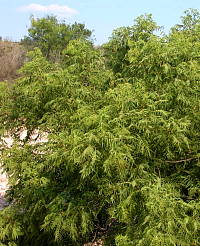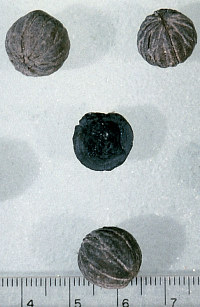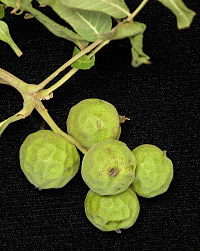Little Walnut [Juglans microcarpa]
The little walnut or nogalito is a small to medium sized tree or large shrub that produces a small nut, about half the size of its larger relative, the black walnut (Juglans nigra). The little walnut is most common in the arroyos and narrow canyons of the western Edwards Plateau but grows over the entire Plateaus and Canyonlands region. The tiny nuts are less than an inch in diameter (1.1-1.7 cm). The nutmeat is rich in vegetable fat, but is not easily separated from the tough, woody outer shell. Dinky, hard nut to crack or not, it was an important food resource precisely because it was a much-need source of fat. Little walnut nuts, cracked and whole, charred and uncharred, are common in the dry rockshelters of the Lower Pecos Canyonlands and charred nut fragments have been found in open campsites on the Edwards Plateau.
Details
Little walnut (Juglands microcarpa; also called little black walnut, littleleaf walnut, Texas walnut, and Mexican walnut) grows as small to medium-sized tree, but it is often shrubby and multi-trunked, springing from the gravelly bottom of a dry arroyo from many small stems. It is most common in the arroyos and narrow canyons of the western Edwards Plateau and Trans-Pecos, but it can be found throughout the plateau, Rolling Plains, and even along the Canadian River of the Texas Panhandle and adjacent areas of neighboring states. Little walnut flowers in early spring but the nuts don't ripen until late summer/fall. The small nut is encased in a leathery, green husk that slowly turns brown as it ripens. Inside the husk, the nut meat or cotyledon is surrounded by a woody pericarp or outer shell. The fat-rich nutmeat has to be separated from the rest of the nut.
There are no ethnographic references to the use of the little walnut, but it is very common in the dry deposits of the rockshelters in the Lower Pecos region, including Hinds Cave. Useful information can be gleaned from what is known about the use of the Arizona walnut, a close relative of the little walnut that grows from the Trans-Pecos westward to northwestern Mexico and Arizona. Powell (1998:73) believes that these two species may hybridize where their ranges overlap, making the comparison all the more relevant.
The Western Apache pounded the walnuts to remove the hulls and washed them in water. They were then pounded more and mixed with baked agave or parched and ground them with maize, eating the resulting mixture (Buskirk 1986; Reagan 1930). The Southeastern Yavapai used a mano and metate to break the pericarp (shell) and winnowed the broken nuts in a basket to separate the meat from the pericarp (shell) (Gifford 1932).
Lacking direct data on the nutritional content of the little walnut, we must rely on studies of its close relatives, primarily the black walnut. From this plant we can understand generally the value of the walnut as a source of fat. Fat is a critical component of the diet, and walnuts would have been one of the few sources of fat in the regional vegetation (Sobolik 1991). Of the 680 kcal available in 100 g (dry weight) of walnut meat, 68% is fat and and 16% is protein. It is no surprise that this rich source of fat was utilized intensively by the occupants of the region.
What archeologists find in the rockshelter deposits are hundreds of fragments of the woody pericarp (nut shell), which is discarded after the nutmeat is removed. These fragments are extremely common, and occurred at Hinds Cave in densities only exceeded by prickly pear seeds (Dering 1999:663). Nut fragments have recently been identified from four open archeological sites in northern Val Verde County where they were dated to about 400 A.D. and 2000-2500 B.C. (Cliff 2003). We know the use of little walnut began much earlier from evidence at Baker Cave on the Devils River. There in the fill of a well-preserved 10,000-year-old hearth, little walnut shell was the most abundant of all the seeds or fruit fragments (Hester 1981:140).
Walnut fragments found in open sites had to be charred to be preserved. Because many of the walnut fragments found in the dry rockshelters are also charred, we infer that fire was probably used to parch, roast, or otherwise treat the walnuts to help loosen the nut meat from the pericarp. Indeed, the Western Apache parched the walnuts before grinding them, according to Buskirk (1986). The large quantities of charred walnut fragments found in Late Paleoindian and Early Archaic contexts in Baker Cave and Hinds Cave in the Lower Pecos Canyonlands, probably attest to the antiquity of this practice.
References
Buskirk, Winfred
1986 The Western Apache: Living with the Land Before 1950. University of Oklahoma Press. Norman.
Cliff, Maynard
2003 Archeological Data Recovery Investigations of Four Burned Rock Midden Sites (41VV1892, 41VV1893, 41VV1895, 41VV1897), Val Verde County, Texas. PBS&J. Doc. 10102, Texas Department of Transportation Archeological Studies Program Report No. 51. Austin.
Dering, J. Phillip
1999 Earth-Oven Plant Processing in Archaic Period Economies: An Example from a Semi-Arid Savannah in South-Central North America./em> American Antiquity 64(4):659–674.
Hester, Thomas R.
1980 Digging into South Texas Prehistory. Corona Press. San Antonio, Texas.
Powell, A. Michael
1998 Trees and Shrubs of the Trans-Pecos and Adjacent Areas. University of Texas Press. Austin.
Reagan, Albert D.
1930 Notes on the Indians of the Fort Apache Region. American Museum of Natural History Anthropological Papers 31(5):63-64.
Hide Details
![]()


